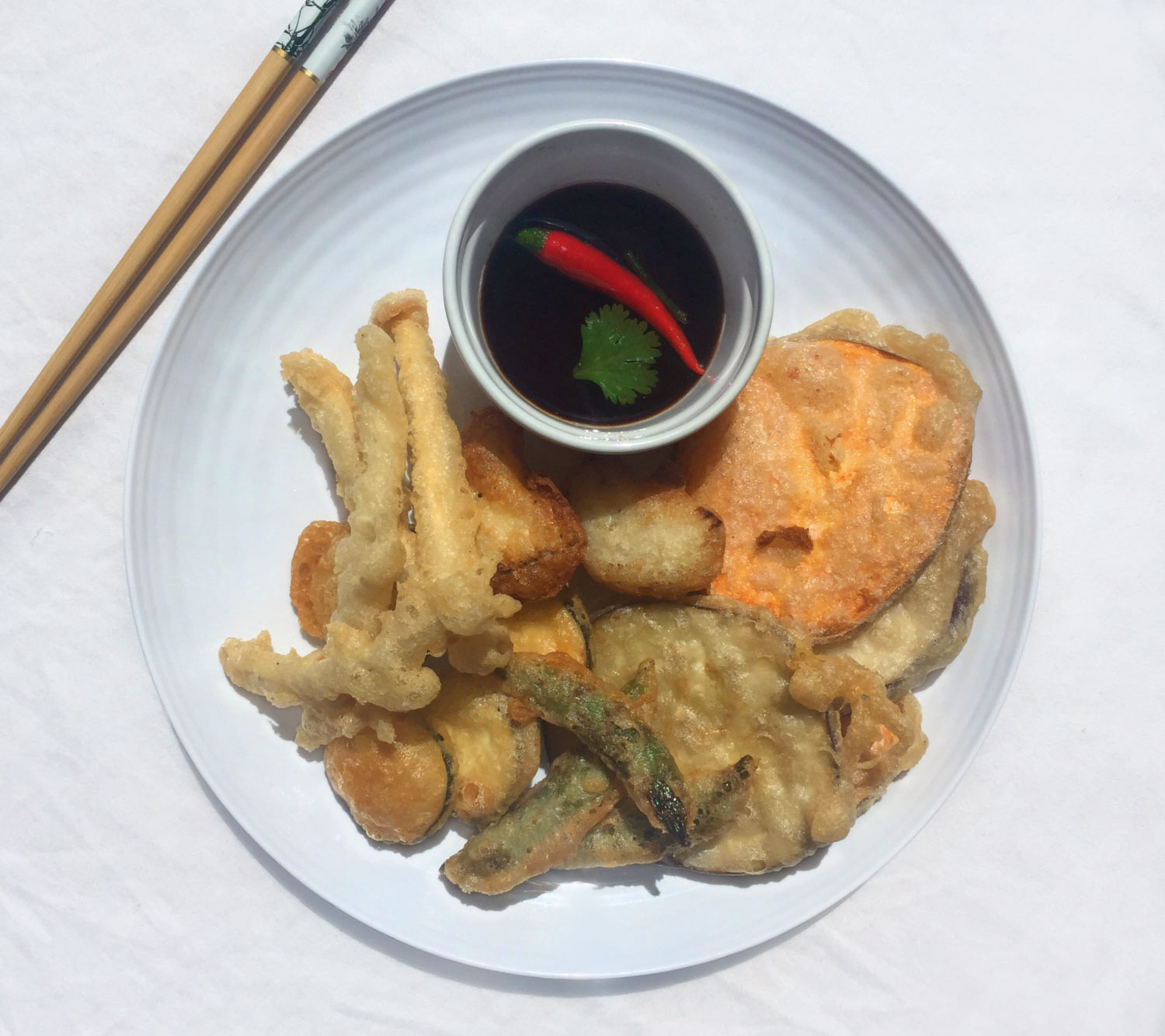Vegetable Tempura With Ginger Garlic Dipping Sauce

So you all know that fried food is bad for you, right?
But I know (and I suspect some of you have the same dilemma as me): it tastes so damn good!
In an attempt to make fried food less bad for me and for all our clients that love it, I wanted to see if we could remove some of the biggest reasons I don’t allow standard fried fare in the NeuroTrition Rx. Specifically, I wanted to see if we could take out the 5 baddest-of-the-bad reasons I’m against fried food, and I wanted to see if it could still taste awesome. Spoiler alert: we did, and it does. We made a healthy version of the much loved fried dish, tempura, that is delicious and drool worthy.
What are the top 5 “baddest-of-the-bad” in fried foods, anyway?
1. Processed Oil —> Good Oil
Tempura typically uses the cheapest, most processed and refined oils. They’re bad for so many reasons, but heating these oils creates a bunch free radicals that you then eat alongside your tempura (or any fried food). So we opted for a high quality almond oil that can still safely be taken to a really high heat.
2. Old Oil —> Fresh Oil
When you’re eating fried food at a restaurant, you never know how many times that oil has been used before your tempura gets in there. Re-using oil increases carcinogenesis (cancer-causing) risk — think about this the next time you get fries at a fast-food place, where often the oil is changed once a day! Make your own tempura at home, and you’ll know your oil was only heated once.
3. Refined Flour —> Better Flour
Standard flours for frying are white, and like most things white in the grain world, it is refined and processed. Specifically, it’s fibre has been stripped, which means it won’t fill you up or help with all the things fibre helps with (eg. weight control, blood sugar balance, heart health, bowel health, etc). So we chose to use a lower glycemic, higher fibre brown rice flour.
4. Soggy, Old Vegetables—> Fresh, Crisp Vegetables
All our chosen veggies, including sweet potatoes, have science-backed brain benefits. Plus, because you’re buying (or growing) them, you’ll make sure they are fresh. Fresh veggies are higher in nutrients and they tend to diminish in important antioxidants like vitamin C the longer they sit around chopped up. Also, nightshades (i.e. eggplant, tomatoes, peppers, potatoes) produce alkaloid compounds that can cause an inflammatory reaction in some people, and they tend to be higher in alkaloids the older they get. Opt for organic if you can to reduce your exposure to brain-draining pesticides!
5. Unhealthy Dipping Sauce —> Healthy Dipping Sauce
When eating out, you don’t ever really know what’s in the dipping sauce. From MSG to artificial flavours and colours to white sugar, it could (and often does) have it all. Our sauce is clean, simple, and only contains brain-loving real ingredients (like ginger).
This tempura and dipping sauce turned out amazingly delicious, and really stood up to the NeuroTrition-ification on multiple tests! I am not here to say that this should become a regular part of your diet, it is still fried food after all! Rather, this is to show you that (yet again, in true NeuroT style), when we unpack and understand what makes something unhealthy (1 - 5 above, in the case of fried food), we can play around with changing those things and make something less bad. This means that, rather than not being “allowed” to have certain foods we love that are unhealthy (which, in my experience with clients usually results in a binge with ensuing guilt and self-loathing), we can tweak and then still enjoy some of our Fave foods from time to time.
Tempura Batter Ingredients:
- 1 egg white
- 1 cup cold sparkling water
- 1 cup brown rice flour
- 1/4 cup arrow root starch
Vegetable Ingredients:
- 1/2 eggplant
- 1 small sized yam or sweet potato
- 1 small sized onion
- 2 cups snap peas
- 10 pieces of enokitake/shiitake mushroom
- 1/2 zucchini
- 4 cups almond oil
Dipping Sauce Ingredients:
- 1/2 cup gluten free soy sauce
- 1/4 cup rice wine vinegar
- 1/2 clove grated garlic
- 1/2 tsp grated ginger
- 1 tsp toasted sesame oil (non-toasted works as well)
- 1 Thai chili
Special Equipment:
- Candy thermometer
- Slotted spoon/chop sticks
- Separate egg yolk from white and whisk egg white in medium sized bowl until lightly frothed.
- Add brown rice flour and arrow root starch.
- Mix in sparkling water. Be sure to leave lumps in batter, as this makes batter fluffy and crispy. Refrigerate mixture while preparing dipping sauce and vegetables.
- In a small bowl mix soy sauce, grated ginger and garlic, rice wine vinegar and toasted sesame oil. Leave Thai chili whole to have a mildly spicy sauce or cut it up to increase spice level.
- Slice yams, eggplant and zucchini 1/8 of an inch, trim edges off onion and cut into 8 uniform pieces.
- In a small sauce pan add 4 cups of almond oil and heat on medium heat, while oil is heating prepare a large plate lined with paper towel
- Measure the oil temperature with the candy thermometer. Once it reaches 350⁰F, drench selected vegetable in tempura batter and carefully lay into hot oil. Fry both sides evenly.
- Once golden brown (approximately 3 minutes) use slotted spoon to remove vegetables from oil onto the paper towel lined plate. Repeat until all vegetables are cooked.
- Serve with chilled dipping sauce and enjoy!

Sweet Potatoes:
- Sweet potatoes contain fibre, mostly insoluble fibre. These insoluble fibres are known to reduce the risk of diabetes, improve gut health and help you manage your weight—all of which are good for your noggin.
- A particular sweet potato extract known as “caiapo” has been termed a “natural insulin sensitizer” because it seems to help improve blood sugar regulation.
Free Range Eggs:
- High in the brain loving nutrient choline. Choline creates the important neurotransmitter, acetylcholine, which is a key ingredient in thinking and memory!
- High in lecithin, a compound that helps improve memory and increases the “happy” cholesterol HDL while lowering the “lousy” LDL.
- References
-
- Bovell-Benjami, A.C. (2007). Sweet Potato: A Review of its Past, Present, and Future Role in Human Nutrition. Advances in Food and Nutrition Research, 52:1-59.
- Cevallos-Casals, B.A. and Cisneros-Zevallos, L.A. (2002). BIOACTIVE AND FUNCTIONAL PROPERTIES OF PURPLE SWEETPOTATO (IPOMOEA BATATAS (L.) LAM). Acta Hortic. 583, 195-203.
- Poly, C., Massaro, J., Seshadri, S., Wolf, P., Cho, E., Krall, E., . . . Au, R. (2011). The relation of dietary choline to cognitive performance and white-matter hyperintensity in the Framingham Offspring Cohort. The American Journal of Clinical Nutrition, 94(6), 1584-1591.










